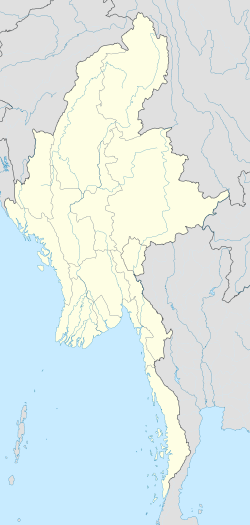Top Qs
Timeline
Chat
Perspective
Pitakataik (Yangon)
Library, religious archive in Yangon, Myanmar From Wikipedia, the free encyclopedia
Remove ads
The Piṭakataik (also called the Buddhist Tripitaka Library) is a pitakataik or Buddhist library located in Yangon, Myanmar. Commissioned by Prime Minister U Nu in the mid-1950s, it was designed to house Buddhist scriptures and writings associated with the Sixth Buddhist Synod.[1] Despite being part of a larger Kaba Aye Pagoda complex, the library remains relatively secluded and is often overlooked by visitors.[1] The library still houses thousands of original Buddhist folding-book manuscripts.[2]
Remove ads
History
U Nu envisioned the library as a spiritual and intellectual repository that would preserve Pāli scriptures from various Theravāda countries, as well as new religious writings produced during the Sixth Synod held in Yangon in 1954–56.[1]
The library was designed by Benjamin Polk, an American architect who had settled in India and partnered with Joseph Allen Stein in New Delhi.[1] Polk was chosen for the project due to his sensitivity to cultural and religious symbolism, and his adaptability to Modernist architecture within traditional contexts.[1]
Construction began around c. 1955 – c. 1956, coinciding with the conclusion of the Sixth Synod. Indian site manager Visvanath Jhanjee oversaw the project, which faced multiple setbacks, including the murder of a Chinese carpenter foreman, the dismissal of the first site engineer due to alcoholism, and political instability, as Prime Minister U Nu was temporarily ousted by General Ne Win from 1958 to 1960.[1]
Despite these challenges, the library was completed around 1960–61, during U Nu’s return to power.[1]
Remove ads
Design

The library is noted for its unusualy modernist radial design. The building is organised in a circular, radial plan, inspired by the Sanchi Stupa in India, while the three stories represent the Three Baskets of Wisdom (i.e., the Tripitaka).[1] The building uses reinforced concrete, allowing for innovative structural elements such as cantilevered Burmese-style arches reminiscent of the ancient architecture of Bagan, and is adorned with lotus motifs at the entrance and throughout the design, evoking Buddhist iconography.[1]
The building was divided into three wings — a public library, an auditorium, and a religious museum — which surround a central core, intended as a sanctuary for monks and scholars, dedicated to study and meditation.[3] The building was centred on landscaped gardens and an artificial lake, which no longer exists.[3]
Remove ads
References
Wikiwand - on
Seamless Wikipedia browsing. On steroids.
Remove ads
